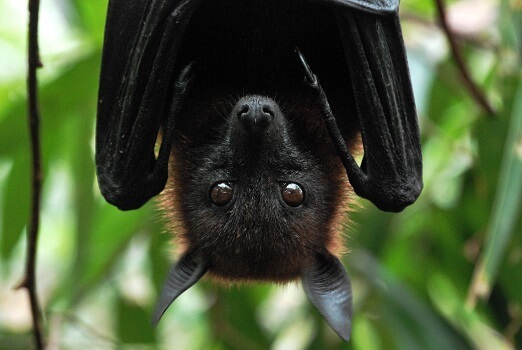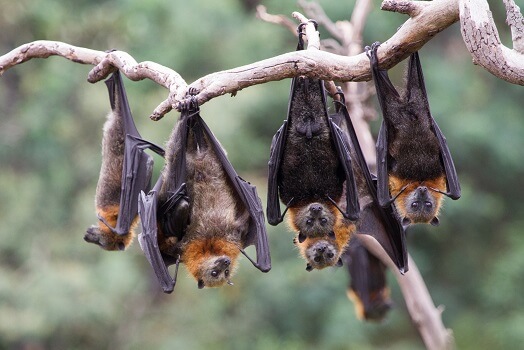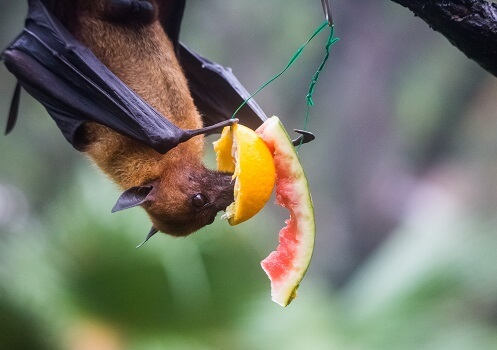
The Flying Fox, also known as the Fox bat, is a genus of megabats (Pteropus). There are over 60 species of bat belonging to this genus and they are found on tropical islands from Madagascar to Australia, and Indonesia to mainland Asia. They are old-world fruit bats. Flying foxes are the largest bats, with some species having a wingspan of 5 feet (1.5 meters) and a head and body length of 16 inches (40 cm). As their common name suggests, the flying fox has a fox-shaped head, with small ears and big eyes. Their toes have sharp, curved claws. These large bats eat fruit and other vegetation and also will consume insects that they locate with their keen sense of smell. Most species are nocturnal and they navigate with their eyesight, as most species can not use echolocation like other bats. These bats have binocular vision and can see in low light conditions. These intelligent animals live in large colonies that are made up of individuals and family groups. They establish permanent and semi-permanent camps in areas that are close to food sources. At dawn and dusk, these flying foxes can be heard making various calls to communicate as they leave to feed or as they return to sleep. As they are mostly nocturnal, they roost in trees during the day. Flying foxes have a long lifespan and a slow reproduction, with most females producing just one offspring per year. This makes them vulnerable to certain threats such as culling, overhunting, and natural disasters. Six species have been made extinct in recent times due to overhunting. Flying foxes are often considered pests by farmers due to the damage that they cause to crops. In particular, flying foxes have been accused of destroying fruit and nut crops in several countries including areca in India; almonds, mangos, and guavas in the Maldives; lychee in Mauritius; and stone fruits in Australia. The IUCN had evaluated 62 species of flying fox by 2018. Of these 62, 3 are considered critically endangered, 7 are listed as endangered, 20 are listed as vulnerable, 6 as near threatened, and 14 as least concern. For the remaining 12 species, 8 do not have enough data to accurately assess their status and 4 are considered extinct. The Grey-headed Flying Fox (Pteropus poliocephalus) is the largest bat species in Australia. It is Australias only endemic flying fox species and is listed as vulnerable by IUCN. The Large Flying Fox (Pteropus vampyrus) is one of the largest species of bat. It has long and woolly hair, with the males having stiffer and thicker coats than the females. The color and texture of the coat can also differ between sexes and age classes. The Indian Flying Fox (Pteropus giganteus) is endemic to South Central Asia. These flying foxes live in tropical forests and swamps and are most likely to be found near water bodies, where they roost among banyan, tamarind, and fig trees. Lyle’s Flying Fox (Pteropus lylei) are found in Vietnam, Cambodia, and Thailand. They also occur in Yunnan province in China. They are a medium-sized bat that is mostly dark in color except for a collar of orange fur. These bats are threatened by loss of habitat, hunting, and persecution by farms and are listed as vulnerable. Little Red Flying Fox (Pteropus scapulatus) are small flying foxes that are exceptional fliers and very good at climbing. They are nomadic bats that move from forest to forest or coastal areas in search of their favorite foods. They are found across northern and eastern Australia. Flying foxes are interesting mammals that live in tropical forests and provide valuable ecosystem services. These winged creatures have several biological adaptations that make them particularly interesting to study. Let’s take a closer look! Flying foxes, like other bats, have a rapid digestion system. They chew and fragment their food exceptionally well. This means that there is a greater surface area on which the digestive enzyme can act. Their digestive system is so rapid that they may begin to defecate within 30 to 60 minutes of eating. This can reduce the load that they need to carry during flight. These bats can consume between 25 and 35% of their body weight daily. Flying foxes are known to carry viruses, including Hendra virus and Australian Bat Lyssavirus. These bats are known hosts for Hendra virus (HeV), which can occasionally spill over to other animals, including horses where it can ultimately cause their death. HeV was first isolated in 1994 from samples obtained in Hendra, a suburb of Brisbane, Australia during an outbreak of the respiratory and neurologic disease in horses and humans. Infection in humans is rare, only seven cases were reported between 1994 and 2013. Australian bat lyssavirus (ABLV) can be transmitted from bats to humans. This virus was first identified in 1996 and is closely related to the rabies virus. It has been found in four flying fox species. ABLV infection in humans can be serious and can result in paralysis, delirium, convulsions, and death. Flying foxes play an important role in keeping tropical forests healthy, by dispersing the seeds of various plants and pollinating flowers. Pollen sticks to the fur on their bodies, which they then carry to other plants as they crawl or fly between flowers and trees. Bats are vital to the functioning of the ecosystems in which they are found and make up close to half of the mammal species found in most tropical forests. These bats are more vital to the ecosystem than once thought. Researchers recently demonstrated that flying foxes are very effective at pollinating durian trees when it was previously thought that they were destructive and caused damage to this crop. In Thailand and Malaysia, the tropical durian fruit is highly prized as it generates millions of US dollars in local and international trade.
Kingdom
Animalia
Phylum
Chordata
Class
Mammalia
Order
Chiroptera
Family
Pteropodidae
Genus
Pteropus
Species
Over 60
Length
Various
Weight
0.26 to 3.53 lb (120 to 1,600 grams)
Lifespan
Up to 15 years in the wild, 30 years in captivity
Social Structure
Social, live in large colonies
Status
Various – some are threatened due to overhunting
Habitat
Tropical Forests
Average litter size
1
Main food item
Fruits, vegetation, and insects.
Main predators
Snakes, birds of prey, and humans
The Basics

Notable Species

Fun Facts about the Flying Fox!
Rapid Digestion
Flying Foxes Carry Viruses

Vital Role in the Ecosystem
